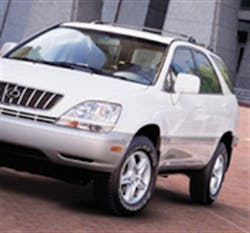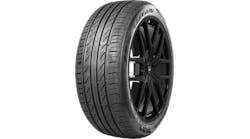SUVs vs. mini-vans vs. vans: The vehicles often get lumped into the 'light truck' category. What about the tires? How different are they, really? And can the market get any more schizophrenic?
The vast majority of tires on sport-utility vehicles are P-metric tires. That makes them passenger tires, although SUVs are classified as light trucks.
Within the SUV segment, "luxury" and "cross-over" vehicles are the fastest growing sub-segments. Both SUVs and pickups are being targeted by the tuner crowd; the resulting "sport truck" segment leads to dressing up a Cadillac Escalade with 26-inch tires and wheels.
However, those tires are still P-metric. And they are light truck tires as well.
Sound confusing? We haven't even touched on mini-van or van tires yet.
Defining(?) the market segments
Given the breakdown of uses for SUVs and the obsessive nature of original equipment vehicle manufacturers, light truck tire size proliferation is hardly a surprise.
Adding to the numbers are tires for mini-vans and vans. How different are they?
"SUVs seem to have a lot of permutations," says Mike Ryan, vice president of administration for Somerset Tire Service Inc. "If you are looking at the 'family wagon' SUV (ES300, MDX), I'd say there is no real reason the tires should be any different than van/mini-van tires. They serve the same purpose and travel the same roads. These folks want a smooth, quiet ride, with decent mileage.
"If, however, you are looking at a segment of the SUV market we'll call the 'macho' vehicles -- those that may or may not go off-road, but must look like they might -- I'd say the biggest difference would be an aggressive tread pattern. (SUV owners) still want mileage, but the ride and noise aren't the highest priorities."
As for true off-road SUVs, like the Land Rover or Mercedes G-Class, Ryan says a durable, aggressive design, "maybe even with an H rating," is needed.
"With all the new crossover vehicles now hitting the market, knowing what the driver intends to do with the vehicle is more important than ever," he adds.
There is no firm definition of an SUV, van or mini-van from a legal or insurance standpoint. Even vehicle manufacturers have trouble pigeonholing the categories as they evolve. Subsequently, light truck tires can be almost anything.
"The different characteristics between vans, mini-vans and SUVs are important to separate," says Steve McGrath, vice president of marketing for Tire Warehouse Central Inc. in Keene, N.H. "SUVs are being equipped with P-metric tires in most cases. The mini-vans are using S- or T-rated passenger tires in most cases. Vans are using P-metric or LT-metric tires depending on vehicle usage.
"If a tire salesperson does not understand when and how to identify these exceptions, prepare yourself for trouble. There are specific replacement applications for many vehicles so it is difficult to answer some questions with a one liner.
"In addition, some SUVs have unique characteristics within the SUV category," he says. "For example BMW, Lexus and Mercedes use H or greater speed ratings on their popular SUV applications, while Ford continues to stress the use of non-speed-rated tires and votes for all-terrain tires."
McGrath says there are a number of sources available to help you determine the right tire for the right vehicle in these overlapping segments. The most important is the vehicle placard and owner's manual or a reliable industry fitment guide.
"Since vehicle manufacturers select tires based on their designed capabilities, they often recommend a type of tire found in the vehicle's owner's manual," he says. "Other tire manufacturers make their recommendations for the same vehicle fitments but may also offer additional features and benefits that the customers may desire. The tire manufacturers also offer Internet recommendations on tire options for vehicles."
McGrath says in some situations, the Internet site may say "no options are found" when exact tire criteria cannot be found for a vehicle. "A critical area is that the sales staff understands the features and benefits of tires they sell and can match up tires that are acceptable. There are times that substitutions from OE will leave a question in consumers' minds and they may feel uncomfortable after a sale.
"Once they fall into that category, any vehicle problems that occur later will be perceived as a (direct) result of the substitution in the consumer's mind."
McGrath says dealers have to avoid potential problems "like selling high-speed cornering effects to some SUV owners.... The false sense of security that we could convey to a customer could result in a rollover condition.
"The customer's desire for more off-road benefits might cause the consumer to reach for a non-speed-rated option and open the door to more legal issues. Again, there are industry-approved policies to follow.
"Tire sellers must stress that they will meet the customers' demands with product choices that stay within these guidelines. I would not want a consumer to think that we create new ones."
Different perspectives
Are tires for SUVs different than tires for mini-vans or vans in any way? We decided to ask tire manufacturers, marketers and dealers this question. Here are their responses.
Mike Barker, vice president of replacement sales and marketing, PLT Division, Continental Tire Inc.: The compounds used in an SUV are no different than those used in a passenger tire of the same class. However, there are differences in reinforcement materials from class to class. As the products move from SL to XL to LR -- D or E -- the appropriate construction is incorporated. These tires are light truck tires and therefore must ultimately perform as light truck tires.
Steve Carpino, director of research and development, Pirelli Tire North America: Yes, in some ways due to some differences in usage. Of course, today there is a wide range of SUVs for different types of applications. In some cases, the tires are very similar to car or mini-van type tires. In other cases, where the SUV is more oriented to off-road performance, the tires can be found to be quite different.
Dennis Cates, vice president of marketing and consumer products, Del-Nat Tire Corp.: (For) sizing and construction, most SUV tires are built on P-metric LT green tires. These typically have more tread rubber.
Ed Cercek, light truck tire engineer, Kumho Tire U.S.A. Inc.: There are many ways to answer this. I am sure that when (General Motors) specs an OE tire for an SUV, those specs would differ from those of a van/mini-van. You would want the tread to have "tractive" capabilities for those seldom/occasional trips off-road. You would probably want the tread to appear a little more "trucky" for the SUV. Ride would be emphasized for all the soccer moms and affluent buyers who are moving up from the mini-van and luxury car markets.
For the aftermarket tuner/market, SUV tires have gone to H/V speed ratings and extremely large rim diameters. Here, maintaining some sort of plush ride is important, while providing the performance levels that the tuners are looking for.
Johnny Chen, worldwide sales manager, Federal Tire Corp.: Yes, SUV tires are different from mini-van (tires). SUV tires are more aggressive and bold in patterns. They are also bigger and stronger in construction. They focus on performance and grip.
Dr. Bin Chung, technical director, Maxxis International--U.S.A.: Yes, tires are manufactured to specifications for the type of vehicle they will be sold for. SUV and mini-van tires are built differently since the application as well as the road conditions are very different.
David Van Emburg, director of product marketing, Michelin North America Inc.: Yes, there is a difference. As many consumers moved from cars/sedans to SUVs, they wanted a more car-like ride. The growing popularity of SUVs has driven the development of products that are specifically targeted to this segment.
Patrick Hyland, national product manager, Yokohama Tire Corp.: While there are some shared sizes, in general, mini-vans have sizes similar to passenger cars while SUVs require larger tires because of the weight of the vehicle, desired off-road performance and aesthetics.
Kevin Lakkis, light truck product manager, Toyo Tire (U.S.A.) Corp.: SUVs are capable of traveling in more rugged terrain than mini-vans. SUVs have an average of two inches more ground clearance than mini-vans. More SUVs offer four wheel drive and more offer low range transfer cases -- for increased off-road traction. The tread design and casing in our SUV tires take into account the vehicles range of capability.
McGrath: We see this SUV tire market being built by a number of tire manufacturers.
The first obvious change for consumers is the appearance. The SUV market continues to see a strong demand for the white lettered tires.
The second demand is for a more aggressive tread pattern. The tire tread patterns are often more aggressive than the original equipment tire and consumers get a greater sense of traction in occasional off-road conditions.
John Pecoraro, product segment manager, house brands, Cooper Tire & Rubber Co.: From a construction standpoint, SUVs and mini-vans equipped with passenger tires (P-metric/metric) are basically the same. The basic difference between the two is that we offer a broader range of SUV products, (i.e., LT, all-weather, all-terrain, high void, all-purpose, winter) to address the wider range of applications that SUVs are subjected to. As we all know, most of them never get off the road, but some can and do -- and others think they will -- so that's why we give those drivers a choice. Mini-vans and vans, on the other hand, almost are always "on-road," so we provide those sizes in only all-season and winter tires such as our Touring SLE, Discoverer H/T, Weather-Master S/T2 and Discoverer M+S.
Jason Shannon, director of marketing, American Tire Distributors: I believe that the manufacturer is in the best position to comment on differences in the actual tires for SUVs vs. tires for mini-vans or vans, but we are starting to see a market segment for "SUV-type" tires emerging. It seems that SUV tires are becoming a segment of the light truck market in a similar way to how touring has become a segment of the passenger market.




